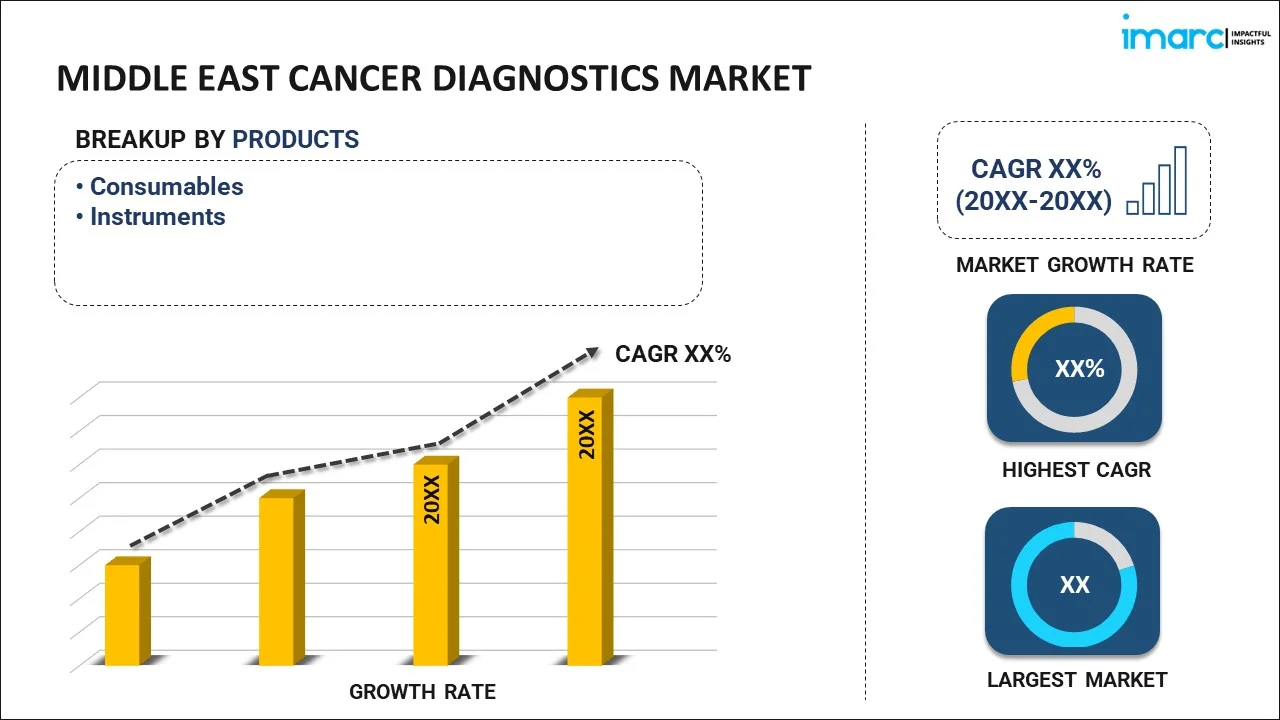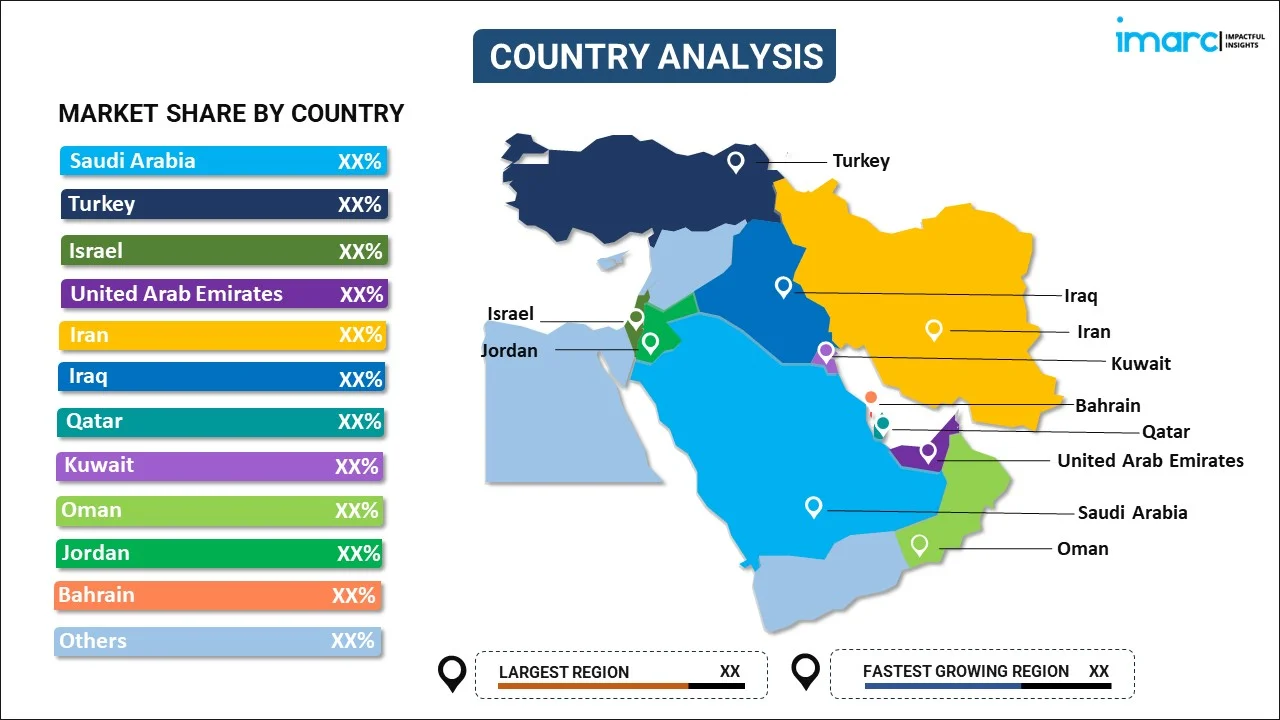
Middle East Cancer Diagnostics Market Report by Product (Consumables, Instruments), Technology (IVD Testing, Imaging, Biopsy Technique), Application (Breast Cancer, Lung Cancer, Colorectal Cancer, Melanoma, and Others), End User (Hospitals and Clinics, Diagnostic Laboratories, and Others), and Country 2024-2032
Market Overview:
Middle East cancer diagnostics market size is projected to exhibit a growth rate (CAGR) of 7.65% during 2024-2032. The growing prevalence of cancer among the masses, rising construction of various hospitals and cancer research centers to provide quality healthcare services to patients, and increasing integration of cutting-edge technologies represent some of the key factors driving the market.
|
Report Attribute
|
Key Statistics
|
|---|---|
|
Base Year
|
2023 |
|
Forecast Years
|
2024-2032
|
|
Historical Years
|
2018-2023
|
| Market Growth Rate (2024-2032) | 7.65% |
Cancer diagnostics refers to the methods and tools used to detect, classify, and monitor cancer. It involves analyzing biological samples or imaging studies to identify abnormal cells or tumors. It employs various imaging modalities, including X-rays, computed tomography (CT) scans, magnetic resonance imaging (MRI), and positron emission tomography (PET) scans, to visualize tumors and assess their size, location, and involvement with surrounding tissues. It involves the removal and examination of a small tissue sample to determine if cancer cells are present. It consists of blood tests, such as tumor markers and complete blood count (CBC), providing valuable information about the presence of cancer cells, the response of the body to cancer, and overall health. It employs various molecular techniques, including next-generation sequencing (NGS), polymerase chain reaction (PCR), and deoxyribonucleic acid (DNA) sequencing, to analyze the genetic and molecular characteristics of cancer cells and assist in identifying specific mutations and guiding targeted therapies. It allows for timely intervention, increasing the chances of successful treatment and improved survival rates. Cancer diagnostics contribute to the era of precision medicine by identifying specific molecular and genetic characteristics of tumors, enabling targeted therapies tailored to individual patients. It also helps in reducing unnecessary treatments and minimizing side effects, thereby enhancing the overall quality of life for cancer patients.
Middle East Cancer Diagnostics Market Trends:
At present, the increasing prevalence of cancer among the masses due to the adoption of unhealthy lifestyles and excessive consumption of alcohol represents one of the crucial factors impelling the growth of the market in the Middle East. Besides this, the rising integration of cutting-edge technologies, such as next-generation sequencing (NGS), liquid biopsy, and artificial intelligence (AI), which enable the comprehensive analysis of genomic alterations, allowing for a more precise and personalized approach to cancer diagnosis and treatment is contributing to the market growth in the region. In addition, the growing demand for non-invasive methods for detecting circulating tumor DNA, ribonucleic acid (RNA), and proteins in the blood, providing valuable insights into tumor dynamics and facilitating early cancer detection, is offering a favorable market outlook. Apart from this, governing agencies and healthcare organizations in the region are increasingly investing in screening initiatives to detect cancer at its earliest stages when treatment options are more effective. This emphasis on early detection improves survival rates and reduces the overall cost of cancer treatment by minimizing the need for extensive and costly interventions at later stages of the disease. Additionally, molecular diagnostic techniques, such as fluorescence in situ hybridization (FISH), enable the identification of specific genetic and molecular markers associated with various cancers. This molecular-level precision allows for more accurate diagnosis, prognosis, and treatment selection. Moreover, the increasing construction of various hospitals and cancer research centers to provide quality healthcare services to patients is bolstering the market growth in the region.
Middle East Cancer Diagnostics Market Segmentation:
IMARC Group provides an analysis of the key trends in each segment of the market, along with forecasts at the regional and country levels for 2024-2032. Our report has categorized the market based on product, technology, application, and end user.
Product Insights:

- Consumables
- Antibodies
- Kits and Reagents
- Probes
- Others
- Instruments
- Pathology-Based Instruments
- Imaging Instruments
- Biopsy Instruments
The report has provided a detailed breakup and analysis of the market based on the product. This includes consumables (antibodies, kits and reagents, probes, and others) and instruments (pathology-based instruments, imaging instruments, and biopsy instruments).
Technology Insights:
- IVD Testing
- Polymerase Chain Reaction (PCR)
- In Situ Hybridization (ISH)
- Immunohistochemistry (IHC)
- Next-Generation Sequencing (NGS)
- Microarrays
- Flow Cytometry
- Immunoassays
- Others
- Imaging
- Magnetic Resonance Imaging (MRI)
- Computed Tomography (CT)
- Positron Emission Tomography (PET)
- Mammography
- Ultrasound
- Biopsy Technique
A detailed breakup and analysis of the market based on the technology have also been provided in the report. This includes IVD testing (polymerase chain reaction (PCR), in situ hybridization (ISH), immunohistochemistry (IHC), next-generation sequencing (NGS), microarrays, flow cytometry, immunoassays, and others), imaging (magnetic resonance imaging (MRI), computed tomography (CT), positron emission tomography (PET), mammography, and ultrasound), and biopsy technique.
Application Insights:
- Breast Cancer
- Lung Cancer
- Colorectal Cancer
- Melanoma
- Others
The report has provided a detailed breakup and analysis of the market based on the application. This includes breast cancer, lung cancer, colorectal cancer, melanoma, and others.
End User Insights:
- Hospitals and Clinics
- Diagnostic Laboratories
- Others
A detailed breakup and analysis of the market based on the end user have also been provided in the report. This includes hospitals and clinics, diagnostic laboratories, and others.
Country Insights:

- Saudi Arabia
- Turkey
- Israel
- United Arab Emirates
- Iran
- Iraq
- Qatar
- Kuwait
- Oman
- Jordan
- Bahrain
- Others
The report has also provided a comprehensive analysis of all the major regional markets, which include Saudi Arabia, Turkey, Israel, United Arab Emirates, Iran, Iraq, Qatar, Kuwait, Oman, Jordan, Bahrain, and Others.
Competitive Landscape:
The market research report has also provided a comprehensive analysis of the competitive landscape in the market. Competitive analysis such as market structure, key player positioning, top winning strategies, competitive dashboard, and company evaluation quadrant has been covered in the report. Also, detailed profiles of all major companies have been provided.
Middle East Cancer Diagnostics Market Report Coverage:
| Report Features | Details |
|---|---|
| Base Year of the Analysis | 2023 |
| Historical Period | 2018-2023 |
| Forecast Period | 2024-2032 |
| Units | US$ Million |
| Scope of the Report | Exploration of Historical and Forecast Trends, Industry Catalysts and Challenges, Segment-Wise Historical and Predictive Market Assessment:
|
| Products Covered |
|
| Technologies Covered |
|
| Applications Covered | Breast Cancer, Lung Cancer, Colorectal Cancer, Melanoma, Others |
| End Users Covered | Hospitals and Clinics, Diagnostic Laboratories, Others |
| Countries Covered | Saudi Arabia, Turkey, Israel, United Arab Emirates, Iran, Iraq, Qatar, Kuwait, Oman, Jordan, Bahrain, Others |
| Customization Scope | 10% Free Customization |
| Report Price and Purchase Option | Single User License: US$ 3699 Five User License: US$ 4699 Corporate License: US$ 5699 |
| Post-Sale Analyst Support | 10-12 Weeks |
| Delivery Format | PDF and Excel through Email (We can also provide the editable version of the report in PPT/Word format on special request) |
Key Questions Answered in This Report:
- How has the Middle East cancer diagnostics market performed so far and how will it perform in the coming years?
- What has been the impact of COVID-19 on the Middle East cancer diagnostics market?
- What is the breakup of the Middle East cancer diagnostics market on the basis of product?
- What is the breakup of the Middle East cancer diagnostics market on the basis of technology?
- What is the breakup of the Middle East cancer diagnostics market on the basis of application?
- What is the breakup of the Middle East cancer diagnostics market on the basis of end user?
- What are the various stages in the value chain of the Middle East cancer diagnostics market?
- What are the key driving factors and challenges in the Middle East cancer diagnostics?
- What is the structure of the Middle East cancer diagnostics market and who are the key players?
- What is the degree of competition in the Middle East cancer diagnostics market?
Key Benefits for Stakeholders:
- IMARC’s industry report offers a comprehensive quantitative analysis of various market segments, historical and current market trends, market forecasts, and dynamics of the Middle East cancer diagnostics market from 2018-2032.
- The research report provides the latest information on the market drivers, challenges, and opportunities in the Middle East cancer diagnostics market.
- Porter's five forces analysis assist stakeholders in assessing the impact of new entrants, competitive rivalry, supplier power, buyer power, and the threat of substitution. It helps stakeholders to analyze the level of competition within the Middle East cancer diagnostics industry and its attractiveness.
- Competitive landscape allows stakeholders to understand their competitive environment and provides an insight into the current positions of key players in the market.
Need more help?
- Speak to our experienced analysts for insights on the current market scenarios.
- Include additional segments and countries to customize the report as per your requirement.
- Gain an unparalleled competitive advantage in your domain by understanding how to utilize the report and positively impacting your operations and revenue.
- For further assistance, please connect with our analysts.
 Inquire Before Buying
Inquire Before Buying
 Speak to an Analyst
Speak to an Analyst
 Request Brochure
Request Brochure
 Request Customization
Request Customization




.webp)




.webp)












